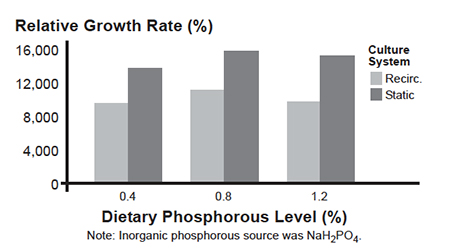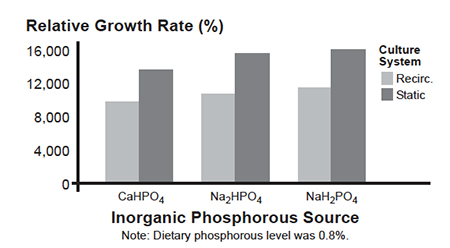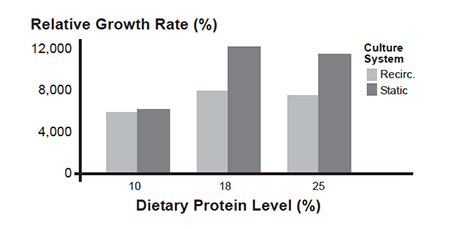Trials conducted at Texas A&M University
The tendency of the shrimp industry to increase production by increasing stocking density also requires increasing aquafeed inputs into culture systems. Feeds and feeding have been identified as the primary causes of water quality problems. Water quality problems at shrimp farms are usually solved by increasing water exchange, which represents a waste of water resources and creates an effluent discharge problem. Therefore, there is growing interest in the development of technologies for water reuse and recycling. But in addition to environmental impact amelioration by reduction or elimination of aquaculture effluent discharge, there may be additional benefits in terms of reduced operational costs (pumping vs. aerating costs, etc.), concomitant production of a second cash-crop (e.g., bivalves), improved management control, and prevention of disease spreading.
Testing recirculating and static systems
A series of 21-day experimental trials conducted at the Shrimp Mariculture Research facility (Texas A&M University) compared the effect of two water management techniques, recirculating and static, on survival and growth of Pacific white shrimp (Litopenaeus vannamei). Feeds with the following were evaluated:
- Three dietary phosphorus levels (0.4, 0.8 and 1.2 percent)
- Three inorganic phosphorus sources (NaH2PO4, Na2HPO4 and CaHPO4)
- Three dietary protein levels (10, 18 and 25 percent).

Results (see Figs. 1-3) showed that shrimp survival ranged from 60 to 100 percent (mean = 82.3 percent) in the recirculating, and from 67 to 100 percent (mean = 86.2 percent) in the static culture system. Shrimp growth ranged from 22.7 to 26.7 percent per day in the recirculating, and from 23.1 to 28.9 percent per day in the static culture system. Shrimp survival was always similar or better for the static culture system compared to the recirculating system.
Shrimp growth was enhanced more than 40 percent in the static culture system for all feeds evaluated, except for the feed containing 10 percent protein, which resulted in similar growth for both systems. Higher concentrations of total ammonia nitrogen and nitrite-N measured in the static system did not seem to have a negative effect on shrimp survival or growth.
Growth-enhancing factors

A better mineralization and utilization of the feed (e.g., coprophagy and development of microflora within the tanks) in the static culture system may have contributed to the increased shrimp growth. Some scientists have suggested that unknown autochthonous factors in shrimp pond-water can stimulate shrimp growth.
Thus, if shrimp are contributing these growth-enhancing factors to the water, growth may have also been stimulated by these factors in the static culture system, where flushing of these compounds was not possible. How much of the growthenhancing effect of the static culture system is due to a better mineralization and utilization of the feed or to unknown growth factors remains to be determined.
Pond water and enhanced production

Scientists at The Oceanic Institute in Hawaii observed that water-column solids between 0.5 and 5.0 microns, autochthonously produced in shrimp pond water, increased shrimp growth when compared to growth rates attained in clear well water, while solids >5.0 microns improved shrimp growth by an additional 36 percent.
Our test results indicate that enhanced shrimp growth is not limited to the use of pond water per se, and can also be obtained under laboratory conditions with clear water if water-column solids are allowed to accumulate in the culture system. The lower growth increase with diets containing 10 percent protein level compared to the others, suggested that this protein level was growth-limiting or that the growth-enhancing factors may be related to the protein fraction of the diet that was present at adequate levels to stimulate shrimp growth at 18 percent protein, but not at 10 percent.
Conclusion
The static culture system did not negatively affect shrimp survival and had a positive effect on shrimp growth compared to the recirculating culture system. This suggests that a combination of both water management regimes may be used concomitantly to optimize the culture system: implementing static conditions at the beginning of the grow-out cycle, when biomass is low, and recirculating water when biomass increases and water quality deterioration may become detrimental to shrimp growth.
Optimization of water management and nutritional strategies should be implemented and further researched, not only in terms of environmental impact abatement, but also in potentially beneficial biological and economical terms.
(Editor’s Note: This article was originally published in the June 2000 print edition of the Global Aquaculture Advocate.)
Now that you've finished reading the article ...
… we hope you’ll consider supporting our mission to document the evolution of the global aquaculture industry and share our vast network of contributors’ expansive knowledge every week.
By becoming a Global Seafood Alliance member, you’re ensuring that all of the pre-competitive work we do through member benefits, resources and events can continue. Individual membership costs just $50 a year. GSA individual and corporate members receive complimentary access to a series of GOAL virtual events beginning in April. Join now.
Not a GSA member? Join us.
Authors
-
Mario Velasco, Ph.D.
Director of Nutrition and Research
Empacadora Nacional
Guayaquil, Ecuador -
Addison Lawrence, Ph.D.
Project Leader
Shrimp Mariculture Research
Port Aransas, Texas USA
Tagged With
Related Posts

Health & Welfare
Ich parasite serves as vector to transmit bacteria to fish
The authors used Ichthyophthirius multifiliis (ich) and fluorescent-tagged Edwardsiella ictaluri to examine whether parasites vector bacteria into fish.

Health & Welfare
Tilapia production using biofloc technology
Biofloc systems enable more intensive tilapia production. The fish adapt to the conditions within biofloc systems and grow well by utilizing the bioflocs as a feed source.

Health & Welfare
Aquaculture could enhance Mediterranean Sea urchin fishery
Although researchers in several countries are working to enhance sea urchin fisheries or commercial production, the development of a major commercial industry has been restrained by the lack of cost-effective production technology.

Aquafeeds
Chemoattraction in aquatic feed management
The value of chemical stimulants to shrimp farming will come via reproducible methods to evaluate the efficacy of chemoattractants and feeding stimulants.


